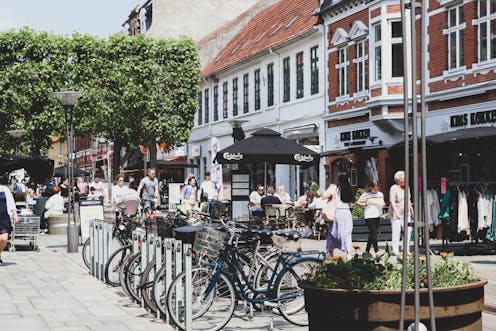What makes an ideal main street? This is what shoppers told us
- Written by Louise Grimmer, Retail Scholar, University of Tasmania

A lot of dedication and effort goes into making main streets attractive. Local governments, planners, place makers, economic development managers, trade associations and retailers work hard to design, improve and revitalise main streets. The goal is to make them attractive places to increase shopper numbers, provide pleasant places for communities, and boost local economies.
Despite the efforts that go into planning, maintaining and marketing local shopping areas, the people who use these places are often not consulted about what they actually want and need on their main street. Our research[1] is the only-known Australian study to ask shoppers about the key elements, and shops and services, they regard as contributing to the ideal main street.
So what types of stores and services do they want?
Pharmacies are the top choice. Intriguingly, four types of stores/services that are disappearing from main streets around Australia – the post office, bank, department store and newsagent – are in the top ten (out of 45 choices in our survey).
What are the key shops and services?
We wanted to find out what consumers see as their ideal local shopping street. What kinds of shops and services matter most for them? Which other elements of local shopping places do they want?
Curiously, users are often not asked these questions. Yet their answers are essential if we are to design new towns, suburbs and regional centres, and improve existing ones, so more people want to work, shop and visit them.
We surveyed a representative sample of 655 shoppers from around Australia about their local shopping preferences.
We provided a list of 45 different stores and services. Participants were asked to rank them in order of importance from one to 45.
Overwhelmingly, participants considered the pharmacy the most important store or service[2] for an ideal main street. Across gender, age and location, pharmacies were consistently number one.
Similarly, four types of stores and services – the post office[3], bank[4], department store[5] and newsagent[6] – appeared in the top ten most important, regardless of demographics.
What other key elements are important?
We then asked participants about the importance of different elements of main streets. We provided 21 elements and participants were asked to rate each on a Likert scale[7] from 1, “not at all important”, to 7, “extremely important”.
Shoppers rated “cleanliness” as the most important element for their ideal shopping area. It was followed by “safety and security” and “parking”.
Aside from the “retail mix”, in most areas local councils have control over nine of the ten top elements. “Safety and security” also involves police and individual security services that centres and some stores employ.
Motivation for shopping affects choices
We also tested for shoppers’ levels of hedonic and utilitarian orientation. Hedonic[8] shoppers really enjoy the act of shopping. They experience euphoria and pleasure and they buy so they can go shopping, rather than shopping so they can buy.
Utilitarian shoppers[9], on the other hand, are rational and cognitive and they view shopping as a task or chore. Buying products they need is simply a “means to an end”. They get no great satisfaction from the activity.
Hedonic shoppers are more often women[10]. Men tend to be more utilitarian. We tend to become more utilitarian as we get older.
We were interested to find out if people’s responses to our questions were different depending on whether they were hedonic (shop for pleasure) or utlilitarian (shop for practical needs) shoppers.
For the most important store or service, hedonic and utilitarian shoppers both rated a pharmacy as number one. And they ranked similar stores and services in their top ten.
But there were some differences. Hedonic shoppers included a lifestyle/gift store and department store in their top ten. Utilitarian shoppers did not. Instead they rated the post office and the newsagent as important.
This finding makes sense. Lifestyle stores, gift shops and department stores offer the hedonic shopper the chance to browse and enjoy quality surroundings and service. The post office and newsagent allow the utilitarian shopper to complete tasks quickly and easily – no browsing required.
Despite similarities in their top-ranked shops and services, hedonic and utilitarian shoppers’ rankings of the most important elements of local shopping areas were starkly different.
For hedonic shoppers, the complete visitor experience, including the surroundings and atmosphere, is an important aspect of their ideal shopping area. Their top ten elements reflected this. They selected a combination of tangible elements, including public art, aesthetics, greenery and lighting, to complement the more ephemeral such as events and activities, night-time economy, sustainability and history and culture.
Utilitarian shoppers rated elements that help make a task-oriented shopping trip easier. Wayfinding[11] (all the ways to help people navigate a space), signage and information, walkability, retail mix, and services and amenities were important for them.
The only two elements both groups agreed should be in the top ten were lighting, and seating and tables.
Making main streets the best they can be
There is an increasing understanding that retailing will not continue to be the main or sole reason people visit town centres. While still important, retail will more often complement services, attractions and “experiences” as the major factors that entice visitors.
This requires local councils, chambers of commerce and marketing organisations to perform a juggling act. They need to market shopping precincts as being attractive for shoppers while showcasing a range of services and attractions in these areas that appeal to other types of visitors.
Making shopping areas the best they can be is challenging work. Different people want different things from main streets.
Our findings provides insights for local councils, which have a primary policy responsibility for main streets, as well as developers, investors and individual store owners. This knowledge can help them better plan and improve the retail and service mix for everyone.
References
- ^ Our research (www.shopology.com.au)
- ^ pharmacy the most important store or service (drugstorenews.com)
- ^ post office (www.afr.com)
- ^ bank (www.abc.net.au)
- ^ department store (www.abc.net.au)
- ^ newsagent (thewest.com.au)
- ^ Likert scale (www.simplypsychology.org)
- ^ Hedonic (www.sciencedirect.com)
- ^ Utilitarian shoppers (www.jstor.org)
- ^ women (www.tandfonline.com)
- ^ Wayfinding (wayfoundvictoria.vic.gov.au)
Authors: Louise Grimmer, Retail Scholar, University of Tasmania
Read more https://theconversation.com/what-makes-an-ideal-main-street-this-is-what-shoppers-told-us-214554







